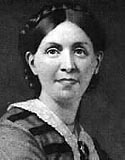Emma Hardinge Britten 1823 - 1899
July 05, 2009
 Emma Hardinge
Britten 1823 -
1899 was a British advocate for the early Modern Spiritualist Movement.
Emma Hardinge
Britten 1823 -
1899 was a British advocate for the early Modern Spiritualist Movement.
Britten was a patient of John Franklin Gray, and Abram D Wilson, and she was a friend of Thomas Henry Burgoyne, Peter Davidson, James Martin Peebles, and James John Garth Wilkinson, and many others.
In 1879, Britten claivoyantly wrote homeopathic prescriptions for many people using automatic writing (Emma Hardinge Britten, Nineteenth Century Miracles: Or, Spirits and Their Work in Every Country of the Earth, (Ayer Publishing, 1884). Page 414).
From http://en.wikipedia.org/wiki/Emma_Hardinge_Britten Due to the publication of her speeches and writing on the spiritual movement, and an incomplete autobiography which was edited by her sister, much of Emma’s life and work is publicly recorded. She is remembered as a writer, orator, and practitioner of the movement.
Her books, Modern American Spiritualism (1870) and Nineteenth Century Miracles (1884), are some of the greatest records of the history of early modern spiritualism movement in America.
Ms. Hardinge was born in London, England in 1823 under the name Emma Floyd. She developed a reputation for apparent abilities as a spiritual medium during her early years. As a child, Emma had a habit of predicting the futures of people she encountered, relating to them what she had seen in visions, along with information about their deceased relatives of whom she had no prior knowledge.
According to her autobiography, Emma’s clairvoyant tendencies drew her into participation with a secret London occult society which used magnetics and clairvoyant techniques for experimental purposes. During this period, she was also exposed to sexism and economic discrimination through her involvement with a manipulative member of the society whom she later termed “a baffled sensualist.” Although there is little reliable information on this London occult group, it is suspected that Emma received the name Hardinge from this society, the surname she kept throughout her adult life.
In 1855, Emma moved to New York to pursue a career in acting. One year later, she was launched to fame as a psychic medium, having accurately predicted the disappearance of the steamship Pacific. Emma had been haunted by feeling of cold and wetness, and a visit from a supposed passenger on the steamship.
After the New York Times published an article describing the incident, Emma was invited by the famous Spiritualist, Horace H Day (who was himself a supporter of homeopathy), to host spiritualist séances in the Society for the Diffusion of Spiritual Knowledge. She deepened her involvement in the Spiritualist movement as a “trance lecturer” and delivered speeches across the country.
Lecture topics included The Discovering of Spirits, The Philosophy of the Spirit Circle, Hades, and What Is the Basis of the Connection of the Natural and Spiritual Worlds?
Hardinge also became involved in the campaign efforts of 1864 in support of Abraham Lincoln’s re-election. After delivering a highly successful lecture titled, The Coming Man; or the Next President of the United States, Emma was invited to continue her political work on a thirty two lecture tour.
Perhaps the culmination of her oratorical career was a speech delivered on April 14, 1865, as a response to Abraham Lincoln’s assassination only thirty six hours prior. Her speech was widely acclaimed by the journalists of the age as her greatest achievement.
Still, not all of her spiritual lectures were so well received. In 1866, The Saturday Review wrote a satirical critique of Ms. Hardinge’s speeches, describing her style as “bloated eloquence” and her content as “bunkum.”
As a chronicle of her active religious participation, Hardinge published the book Modern American Spiritualism (1870), a huge “encyclopedia” of the people and events associated with the early days of the movement.
That same year, Emma married an ardent spiritualist, William Britten, from Boston. Emma continued to publish under the surname Hardinge, however, since her professional career was well developed before this late life marriage.
In 1872, Emma attempted to start a magazine, The Western Star, however, after a series of devastating fires in Boston, her impoverished clients dropped their subscriptions. The magazine failed after only six issues.
Emma then moved back to New York, where she became involved in theosophy. She was also one of six founding members of the Theosophical Society with Helena Blavatsky until they had a falling out.
She also edited a book called Art Magic or Mundane, Sub-Mundane and Super-Mundane Spiritism: A Treatise in Three parts and Twenty Three Sections on the subject of Theosophy. It was written anonymously and published in 1898 by Progressive Thinker Publishing House,Chicago. There remains a strange mystery regarding its authorship. In addition, in 1887 she founded The Two Worlds, a weekly Spiritualist newspaper.
From 1878 to 1879, Emma and her husband worked as Spiritualist missionaries in Australia and New Zealand. After returning to New York, she wrote her greatest chronicle of the spiritualist age - Nineteenth Century Miracles (1884).
Emma Hardinge died in Manchester, England in 1899.
She is credited with defining the seven principles of Spiritualism which, with minor changes, are still in use today by the Spiritualists’ National Union in the United Kingdom. They are:
- The Fatherhood of God.
- The Brotherhood of Man.
- The Communion of Spirits and the Ministry of Angels.
- The Continuous Existence of the Human Soul.
- Personal Responsibility.
- Compensation and Retribution hereafter for all the good and evil deeds done on earth.
- Eternal Progress open to every human soul.
(In the Spiritualist tradition, it is also proper to acknowledge the “Motherhood of God and the Sisterhood of Man”.)